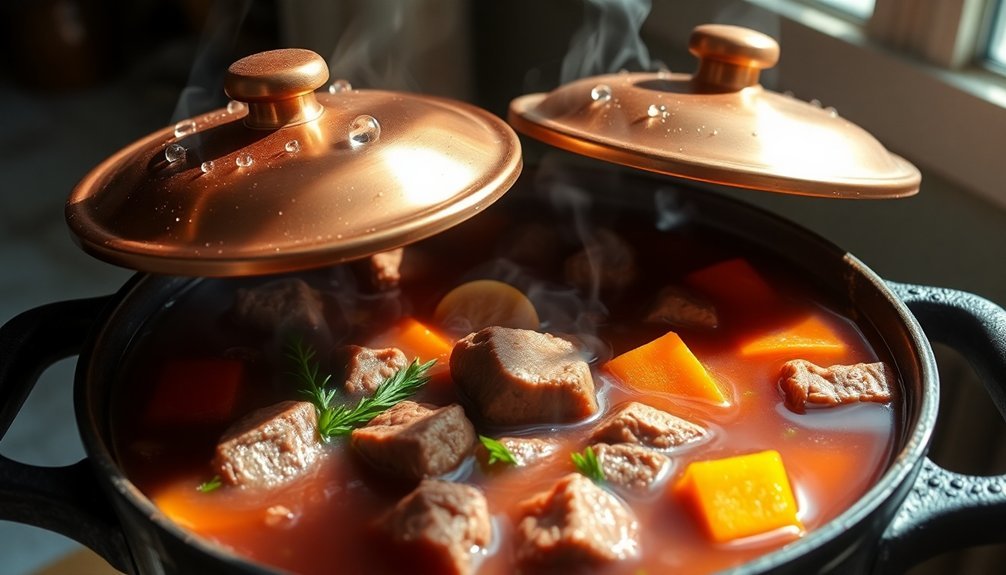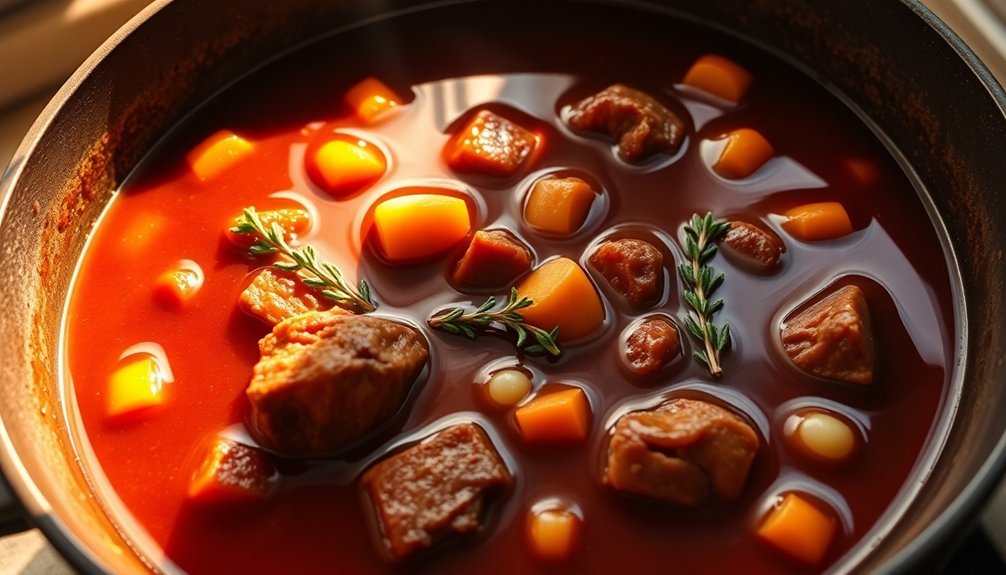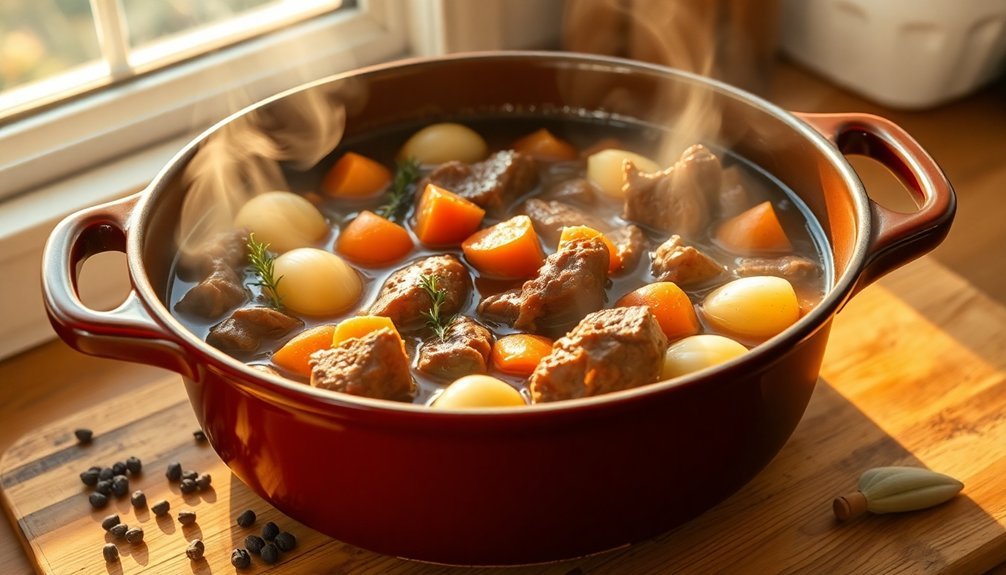Create supremely juicy sun-simmered stews with three proven techniques that deliver consistently delicious results. First, employ the double-lid moisture lock method by placing one lid directly on the pot and a second lid for an airtight seal, trapping essential flavors. Next, maintain precise temperature control between 185-205°F, using visual cues like occasional bubbles to confirm proper simmering. Finally, master the ideal 3:2 liquid-to-solid ratio, dividing ingredients evenly between meat, potatoes, and vegetables. These foundational methods will transform your stews from good to exceptional, with plenty more secrets to discover along the way.
Double-Lid Moisture Lock Method

While traditional stewing methods often let precious moisture escape, the double-lid technique transforms your cooking by creating an air-tight seal.
Just like the LOC method for hair care, where you layer products to lock in moisture, you'll use two lids to trap essential liquids in your stew.
Start by placing your first lid directly on the pot, then add a second lid on top. This creates a layered barrier similar to how oils and creams seal moisture into hair strands.
The double-lid system works like the oil phase of the LOC method, preventing evaporation and keeping flavors concentrated. The approach mirrors how lightweight oils lock in moisture during the second step of proper hair care routines.
You'll notice your stews retain more natural juices, resulting in tender meat and vegetables that haven't dried out during the slow cooking process.
For best results, check the seal between lids periodically.
Low-Temperature Extended Simmer Control
Building on our moisture-retaining methods, mastering temperature control takes your stew-making to the next level.
You'll want to maintain a slow simmer between 185-205°F, where you'll see minimal steam and gentle bubbles breaking the surface. If your stovetop runs hot, try moving the pot slightly off-center or using a flame tamer ring for consistent heat. Using a slotted spoon helps monitor ingredients while keeping them submerged in the simmering liquid.
For tough cuts of meat, stick to a low-temperature extended simmer. You can monitor this visually – look for occasional bubbles rather than continuous movement.
When needed, adjust the heat by adding warm broth or repositioning your pot. Remember that a heavy-bottomed pot with a tight lid is essential for maintaining steady temperatures.
This slow, patient approach will reward you with tender meat and rich, well-developed flavors in your finished stew.
Liquid-to-Solid Ratio Mastery

Understanding the perfect liquid-to-solid ratio is essential for crafting a well-balanced stew. You'll want to start with a 3:2 liquid-to-solid ratio, ensuring your ingredients are just covered with liquid but not drowning in it.
When working with meat and vegetables, divide your ingredients into thirds: one-third meat, one-third potatoes, and one-third additional vegetables. Using a crockpot slow cooker makes maintaining these ratios easier while ensuring even cooking.
Remember that certain ingredients like potatoes and carrots release water during cooking, so start with less liquid than you think you'll need.
You can combine different liquids for enhanced flavor – stock, wine, V8 juice, or even milk.
As you cook, monitor the consistency and adjust accordingly. If it's too thin, add thickeners like roux or polenta. If it's too thick, gradually incorporate more heated liquid while stirring regularly.
Frequently Asked Questions
Can I Substitute Vegetables Without Affecting the Cooking Time of Meat?
You can add vegetables without changing meat's cooking time, but you'll need to add them in stages – firm veggies first, softer ones later. Just maintain your original meat cooking duration.
How Do I Prevent My Stew Meat From Becoming Stringy and Tough?
You'll prevent stringy, tough stew meat by letting it reach room temperature first, searing it before adding to liquid, and cooking low and slow. Don't rush the process or boil the meat.
Should I Remove Bay Leaves and Herb Stems Before Serving?
Yes, you'll want to remove bay leaves and herb stems before serving. They're inedible and can be unpleasant to bite into. Plus, leaving bay leaves in too long can make your dish bitter.
When Is the Best Time to Add Wine to a Stew?
You'll want to add wine right after browning your meat and cooking aromatics. It's best to use it for deglazing your pot, as this helps scrape up those flavorful browned bits into your stew.
Does Browning Meat First Really Make a Difference in Flavor?
Yes, browning your meat first makes a huge difference! You'll create rich flavors through the Maillard reaction, develop a flavorful crust, and get those delicious browned bits that'll enhance your sauce's depth.
In Summary
You'll find these three stewing techniques transform ordinary ingredients into succulent, flavor-packed meals. By mastering the double-lid method, you'll trap essential moisture, while precise temperature control guarantees tender, never-tough results. When you nail the perfect liquid-to-solid ratio, you're assured a stew that's neither soupy nor dry. Put these methods into practice, and you'll never serve a mediocre stew again.





Leave a Reply